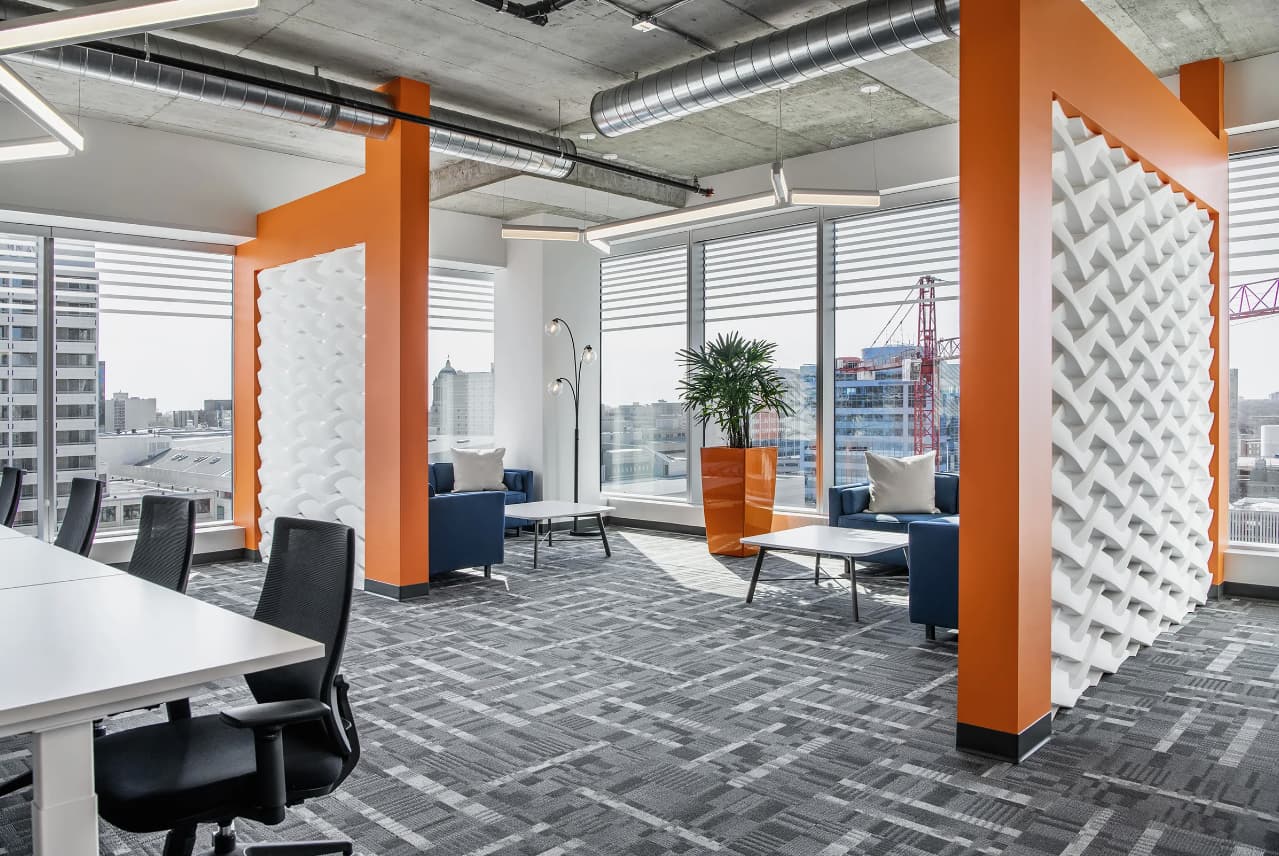With the Canadian unemployment rate hovering around 5%, businesses feel the increased pressure to keep their employees, with more than half implementing plans to improve or maintain retention.
Notably, employers surveyed focused on increasing wages (53.3%) and employee benefits (14.5%). While these are valid efforts, a powerful strategy is being left out of most companies’ employee retention playbook — workplace design.
Workplaces of the past were full of muted color schemes, partitioned spaces that limited employee interactions, and offered few if any, wellness-focused areas. Employees now readily reject these environments, preferring to work from home than in drab, uninspiring, and constrictive environments.
Maintaining relevance to hybrid worker demands and desires in your organization might be the difference between retaining a robust and highly talented workforce and losing your employees to a competitor willing to take the modern worker’s unique needs seriously.
The Rise of Hybrid Work and Its Implications on Employee Retention
Research has shown that employees’ physical environment impacts their productivity, performance, and long-term well-being. And, even though 62% of Canadian employers say they’ve adopted a hybrid work model, only 24% of work environments have been redesigned in the past three years.
81% of Canadian employees factor in flexible work policies when deciding if they’ll stay at their current workplace or leave for better working conditions elsewhere. Employees with agency over where and how they work report higher levels of innovation, collaboration, learning, and performance. These studies clarify that a cutting-edge workplace design strategy is crucial to amplifying employee retention efforts.
Workplace Design Strategy: More Than Just Aesthetics
A good workplace design strategy starts with identifying your company’s vision and goals. Next, your values, desired culture, and employee preferences should be gathered, understood, and integrated into your approach. Last, a design for your space that suits your unique needs can be created.
Optimizing how you use your space to provide ideal working conditions for a diverse workforce increases productivity and employee well-being. Integrating accommodative ergonomics through furniture choices and other components contributes to employee safety and comfort. Creating an aesthetic that is both on-brand and motivating for your employees leverages your space, turning your office environment into an asset that pays dividends in employee inspiration and engagement.
Gensler Research Institute found that “high-performing amenity-rich workplaces have twice the impact on individuals, teams, and organizations when evaluating factors such as personal productivity, sense of community, and awareness of workflows — demonstrating the significant return that a well-designed office can deliver.”
4 Ways Your Office Design Can Enhance Employee Retention
Increasing Job Satisfaction
It’s simple. Satisfied employees, stay. An environment where employees can truly do their best work, with the least distractions, on a regular basis goes beyond just getting the most you can out of your employees.
A strategic office environment can help employees focus on groups of relevant tasks and team members while ensuring access to the right resources at the right time. Structured layouts and design elements can increase how productive employees feel (and are), contributing to the kind of job satisfaction that improves employee retention.
Fostering Connection and Collaboration
Workplace design can either divide or unify your teams. And, since a large part of what people enjoy about their jobs is the people they work with, we encourage focusing on the latter. Discouraging interaction between employees can lead to tension in the workplace, increased miscommunications, and lower job satisfaction.
In-office time can also prove vital to fostering relationships between colleagues and between new and experienced employees or mentors and mentees. 48% of Canadians say they’d be willing to add another in-office day to their work weeks if their work environment was improved, further emphasizing the role of workplace design in drawing employees into connection and collaboration.
Providing Freedom and Flexibility
The freedom and flexibility of a strategic workplace design can honor various employee needs and preferences. From virtual meeting pods to interesting seating options, a workplace full of possibilities increases employee autonomy. By honoring that some employees will prefer a couch to a desk and others will want large tables to spread their things across rather than a small cubicle workspace — companies can show that they value their employees as individuals.
Dual-purpose furniture, convertible spaces, and nooks with a coffee shop aesthetic can contribute to a dynamic environment that will increase the likelihood of employees sticking around, too.
Enhancing Corporate Culture
Give your employees a reason to rave about your company, and you’ll be well on your way to building brand loyalty that improves employee retention. An office your employees are genuinely excited to come into and feel they are an integral part of can be just that reason. Consider the corporate culture you want to contribute to as you envision your workplace transformation. The experience you create can either build up or tear down how valued your employees feel every day at work.
Workplace design gives future-focused employers a competitive advantage that attracts and retains top talent, engages new and existing employees, increases productivity and job satisfaction, and enriches workplace culture — unifying teams across the company.
Joining the smart minority of companies in strategically updating and upgrading your workplace design could be the difference between fighting for employees in the marketplace and having the capacity to focus your existing employees on bigger visions and better business outcomes.
Contact one of our consultants today to get started developing your own workplace strategy. We’re here to help!


.jpg)
.jpg)
.jpg)